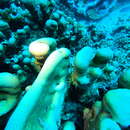Biology
provided by World Register of Marine Species
zooxanthellate
van der Land, J. (ed). (2008). UNESCO-IOC Register of Marine Organisms (URMO).
- license
- cc-by-4.0
- copyright
- WoRMS Editorial Board
Description
provided by World Register of Marine Species
The species has distinctive colonies which are basically massive, but with numerous club shaped or cylindrical, stout columns. These columns divide, and are usually oval in cross-section, and then remain separate from adjacent columns. The typical, star shaped Pavona corallites are clearly visible in live corals, and like most Pavona, the corallite walls are thick, so the calices are well separated. The smooth edged septa cross the broad walls. This is common in the central Indian Ocean, and has been listed for the northern Red Sea, but if present, it is extremely rare there. The colonies commonly reach a metre high and a metre across. The living colour is usually brown or green (Sheppard, 1998). Colonies are columnar or laminar, or both. Columns divide but do not anastomose. Corallites are thick-walled. Columellae are short or absent. Colour: uniform pale grey, cream or brown. Abundance: common on some shallow upper reef slopes exposed to currents, and may be dominant coral forming extensive monospecific stands (Veron, 1986). Grows in plates or stout columns, or a combination of both. Colour: varies from pale grey or green to yellowish-brown. Habitat: shallow reefs with strong currents (Richmond, 1997)
Roux, J.P. (2001) Conspectus of Southern African Pteridophyta. Southern African Botanical Diversity Network Report 13 Page 118 (Includes a picture).
- license
- cc-by-4.0
- copyright
- WoRMS Editorial Board

